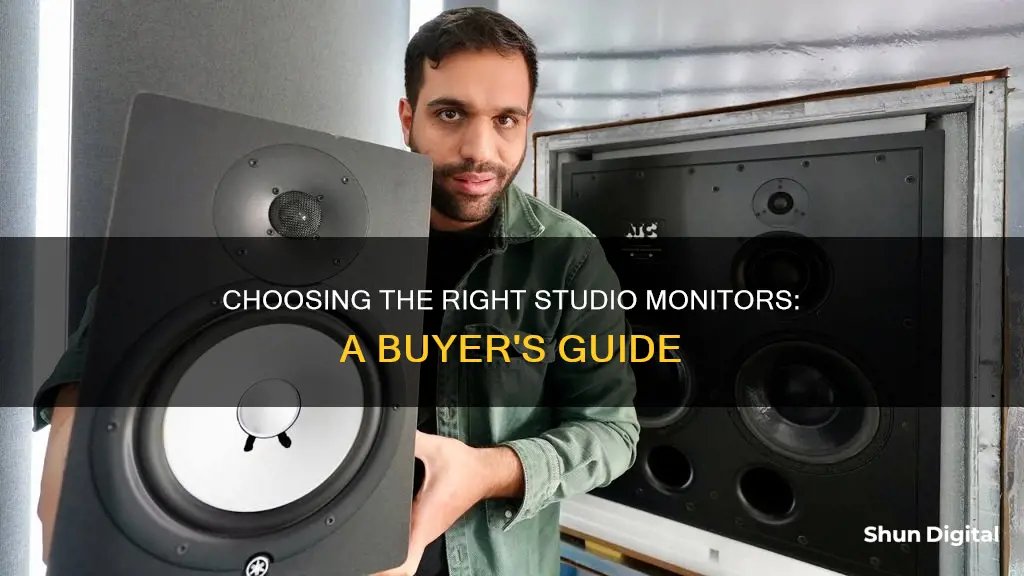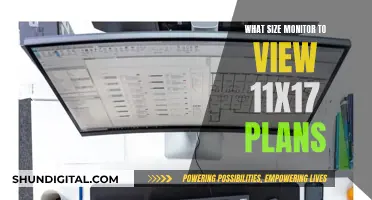
Studio monitors are an essential part of any audio engineer or music producer's setup. Unlike standard speakers, which are designed to enhance the sound of recordings, studio monitors aim to provide an accurate reproduction of the original recording. This allows users to mix and master their audio to ensure the finished product sounds as impressive as possible, regardless of whether it's played on high-end speakers or cheap headphones.
When buying studio monitors, it's important to consider factors such as your budget, the size of your studio, the power wattage you require, and the acoustics of your recording space. Other specifications to look out for include the number of drivers, the type of enclosure, and the presence of built-in amplifiers or equalization controls.
The market offers a wide range of studio monitors, from basic entry-level sets to high-end monitors costing thousands of pounds. By understanding your needs and making an informed decision, you can find the perfect monitors for your studio setup.
What You'll Learn

Active vs passive monitors
When it comes to studio monitors, you'll have to choose between active and passive models. Active monitors have built-in amplifiers, making them simpler to use and set up. They also eliminate the need for extra rack gear and ensure that the internal amplifier is specifically matched to the speaker for optimal sound quality. However, they tend to be heavier and more expensive. Passive monitors, on the other hand, require external amplifiers, which offer more flexibility. With passive monitors, you can upgrade the speaker and amplifier separately, allowing for a more gradual progression to better-quality gear. This makes passive monitors a more cost-effective option, especially if you're on a tight budget or have limited space.
If you're a beginner, it's generally recommended to go for active monitors as they are easier to use and more common in today's market. However, if you're looking for flexibility and are willing to put in some extra effort, passive monitors might be a better choice.
Blue Light and LCD Monitors: What's the Truth?
You may want to see also

Monitor size
When it comes to studio monitor size, the most important consideration is the size of the woofer, as this will determine the low-frequency output of your monitor. If you want to be able to hear the lower octaves of your music, you should opt for a larger woofer. However, it's worth noting that even a well-built six-inch speaker can get pretty close to the lowest audible frequency (20Hz).
In general, larger studio monitors will provide you with more dynamic range and less distortion, a further listening distance, and deeper bass response. They tend to have more powerful amplifiers, which provide a more detailed sound across a wider dynamic range and allow for higher volume levels without distortion. This is especially important if you have a large studio, as you will need greater wattage to fill the space.
That being said, monitor size is not the only factor that determines sound quality. Smaller speakers with high wattage values can also produce sound waves with high dynamic range and low-level distortion. Additionally, the shape of the speaker cabinet and the presence of a reflex port can also impact the bass response of your monitors.
When choosing the size of your studio monitors, it's important to consider the size of your studio and your budget. If you have a small studio or are just starting out, you may want to opt for smaller, more affordable monitors. On the other hand, if you have a large studio or are an experienced engineer, you may require larger, more advanced monitors.
Monitoring Bandwidth Usage: Firewall's Role and Importance
You may want to see also

2-way, 3-way, bi-amped, tri-amped
When buying studio monitors, it's important to understand the difference between 2-way, 3-way, bi-amped, and tri-amped systems. These terms refer to the number of amplifiers and drivers in the monitors.
A 2-way or bi-amplified system uses two drivers: a woofer for the lower frequencies and a tweeter for the higher frequencies. This is the most common configuration for studio monitors, as it allows for accurate reproduction of the entire audio frequency spectrum.
A 3-way or tri-amplified system adds a third driver, a mid-range speaker, to further split the signal into low, mid, and high ranges. This configuration is often found in higher-end monitors to achieve even greater accuracy across the frequency spectrum.
Bi-amped and tri-amped systems refer to the number of amplifiers used to power the drivers. In a bi-amped system, there are two amplifiers, while in a tri-amped system, there are three amplifiers. Each amplifier is dedicated to a specific frequency range, ensuring that each driver receives the appropriate amount of power.
When choosing between a 2-way and 3-way system, consider the level of accuracy and detail you require in your studio monitors. If you are a professional engineer or producer, a 3-way system may be a better option, as it provides greater accuracy and a wider frequency response. However, 2-way systems are still very common and can provide excellent results, especially for home studios or those on a budget.
When deciding between a bi-amped and tri-amped system, take into account your budget and the level of precision you require. Tri-amped systems tend to be more expensive but offer improved sound quality and accuracy. Bi-amped systems are more common and provide adequate power and precision for most users.
University WiFi: Staff Privacy and Monitoring Concerns
You may want to see also

Monitor accuracy
Studio monitors are designed to provide an accurate reproduction of the original recording, giving you a clear idea of what your audio sounds like so that you can mix and master to ensure the final product sounds impressive.
When buying studio monitors, it's important to remember that they prioritise accuracy over sounding good. Unlike regular speakers, studio monitors don't enhance the sound of your audio. Instead, they offer a flat, neutral, or transparent sound that doesn't emphasise certain parts of the recording. This flat sound is crucial for audio editing as it allows you to identify and address any issues that may cause distortion when played back on poor-quality speakers.
To ensure accuracy, look for studio monitors with a wide frequency range, minimal distortion, exceptional stereo imaging, and a high volume level. A good studio monitor will accurately reproduce both high-end and low-end frequencies without distortion. Additionally, consider the total harmonic distortion (THD) and signal-to-noise ratio specifications, as these indicate how accurately the monitor can reproduce the original audio signal.
The room acoustics and monitor placement also play a significant role in accuracy. Ensure your recording space has appropriate acoustics by treating the room to minimise the impact of sound reflections and resonance. Place your monitors away from walls if possible, and consider using speaker stands to optimise their height. The standard configuration for stereo monitoring is to create an equilateral triangle with the speakers placed equidistant from both the listening position and each other.
Some studio monitors also come with built-in EQ controls or "room control" switches, which can be used to adjust the sound to compensate for the acoustics of your room. These features are especially useful if you don't have the option to treat your room acoustically.
Lastly, remember that familiarity with your studio monitors is just as important as accuracy. As long as you know the sound of your speakers intimately, you can achieve great results without breaking the bank for the flattest frequency response.
Best Grand Caravan Models with Second-Row LCD Monitors
You may want to see also

Budget
When it comes to buying studio monitors on a budget, there are a few things to keep in mind. Firstly, it's important to understand that monitors are an essential component of any home studio and can greatly improve the quality of your recordings and mixes. While they can be a significant investment, there are some great options available for those on a budget.
When choosing budget studio monitors, it's important to consider the size of the monitors and the size of your studio space. Smaller monitors with 3-inch to 5-inch woofers are typically more affordable and are well-suited for home studios or small spaces. If you have a larger studio, you may want to consider larger monitors with 7-inch or 8-inch woofers, but keep in mind that these will also be more expensive.
In terms of specific models, here are some recommended budget studio monitors:
PreSonus Eris E3.5
The PreSonus Eris E3.5 is an excellent option for those on a tight budget, often available for less than $100 per pair. They offer a surprisingly good sound quality for the price, with a frequency response of 45 Hz - 20 kHz and a 2-way speaker configuration. The low-frequency response is very good for their size, and they provide a range of connection options, making them a versatile choice.
M-Audio BX5-D3
The M-Audio BX5-D3 is another great budget option, delivering articulate sound through 5-inch woofers at a low price. They offer a wide frequency range and useful features for beginners, such as room correction and a built-in LED light to ensure optimal angle placement. While the low mids could be better, these monitors provide excellent value for money and are well-suited for mixing tracks on a budget.
Adam Audio T5V
If you can stretch your budget a little further, the Adam Audio T5V monitors are an excellent choice, offering superb sound and connectivity for under $500 per pair. They deliver a beautifully tuned top-end with a wide sweet spot, and the overall imaging and stereo separation are fantastic. The low mid-range frequencies are slightly obscured, but this can be remedied by adjusting the low-frequency EQ.
JBL 305P Mk2
The JBL 305P Mk2 is another fantastic option for mixing on a budget, offering fantastic clarity, especially in the mid-range. They have a wide stereo image, making mixing easier, and provide excellent value for money, with a price point of just under $300 per pair.
Mackie CR3-X
For an entry-level option, the Mackie CR3-X delivers decent sound quality with a surprisingly accurate response for its size and price. While it lacks deep bass, the mids and highs are clear and it is well-suited for beginners or small studios. At $100 per pair, it's a super-affordable option.
In addition to these options, there are several other budget-friendly studio monitors available from brands like Yamaha, KRK, IK Multimedia, and Alesis. When making your decision, be sure to consider your specific needs, the size of your studio, and your budget.
Connecting Apple Monitors to Alienware: A Comprehensive Guide
You may want to see also
Frequently asked questions
Most monitors today are active, meaning they have built-in amplifiers. Passive monitors, on the other hand, require an external amplifier and are less common. Active monitors are generally easier to use and a better option for beginners.
If you want to hear the lower octaves of your music, larger woofers are preferable as they produce more low-frequency output. However, even a well-built six-inch speaker can get fairly close to the lowest audible frequency (20Hz).
These terms refer to the number of amplifiers and drivers in a monitor. A 2-way or bi-amplified system has two drivers – a woofer for lower frequencies and a tweeter for higher frequencies. A 3-way or tri-amplified system adds another driver to further split the signal into low, mid, and high ranges.
The amount you spend on monitors depends on your goals and how serious you are about your work. Home recordists can get great results with monitors in the $300-500 range, and even better results with monitors in the $500-$1,000 range. Monitors for professional studios can cost $5,000 or more.







